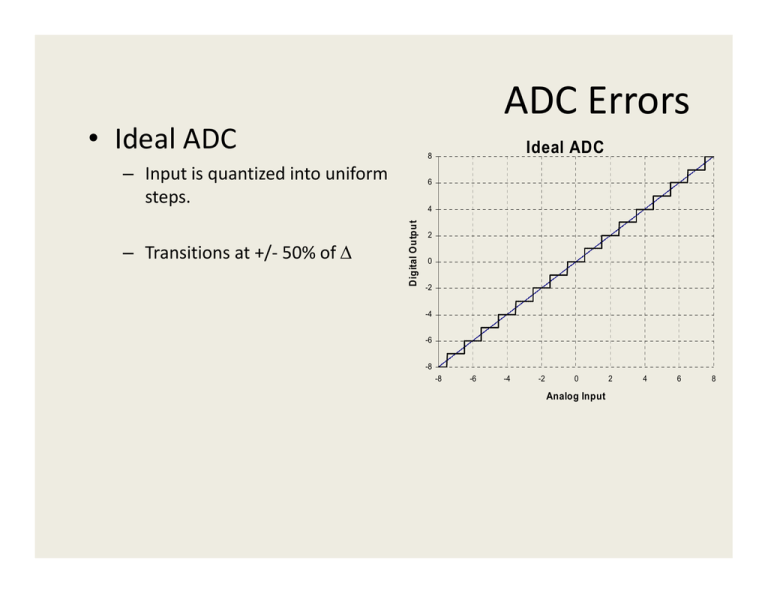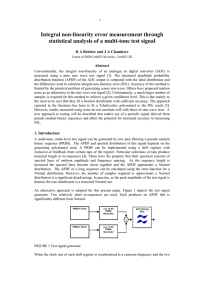Definitions of INL and DNL in an ADC
advertisement

ADC Errors • Ideal ADC – Input is quantized into uniform steps. 6 4 D igital Output – Transitions at +/- 50% of ∆ Ideal ADC 8 2 0 -2 -4 -6 -8 -8 -6 -4 -2 0 Analog Input 2 4 6 8 ADC Errors • Offset Error – Expressed as number of LSBs (counts) – Total system offset error includes offset error from preamplifiers or signal transducers. 6 4 D igital Output – Defined as a constant difference, over the whole range of the ADC, between the actual output value and the ideal output value. Offset Error 8 2 0 -2 -4 -6 -8 -8 -6 -4 -2 0 2 Analog Input Offset error can be removed be measuring a reference point and subtracting that value from future samples. 4 6 8 ADC Errors • Gain Error – Expressed as a percentage. – Total system gain error includes any gain errors from preamplifiers, attenuators, or signal transducers. 6 4 D igital Output – Defines as the difference of the slope of the actual output values and the ideal output values. Gain Error 8 2 0 -2 -4 -6 -8 -8 -6 -4 -2 0 2 4 Analog Input Gain error can be removed be measuring a second reference point to determine the actual gain. 6 8 ADC Errors • Differential Non-Linearity – Any deviation from the ideal step width is the Differential NonLinearity. (DNL) – Expressed as counts. 6 4 Digital Output • For an ideal ADC the output is • divided into 2n uniform steps • each with the width ∆. DNL Error 8 2 0 -2 -4 -6 -8 -8 -6 -4 -2 0 2 4 Analog Input DNL is a function of each ADC’s particular architecture. It is not possible to remove its effects with calibration. 6 8 ADC Errors • Integral Non-Linearity INL Error • DNL errors accumulate to produce a total Integral NonLinearity (INL). – Measured from the center of the step. – Expressed as counts. 6 4 D igital Output – Defined as the maximum deviation from the ideal line. 8 2 0 INL -2 -4 -6 -8 -8 -6 -4 -2 0 2 4 6 Analog Input INL is a function of each ADC’s particular architecture. It is not possible to remove its effects with calibration. 8











